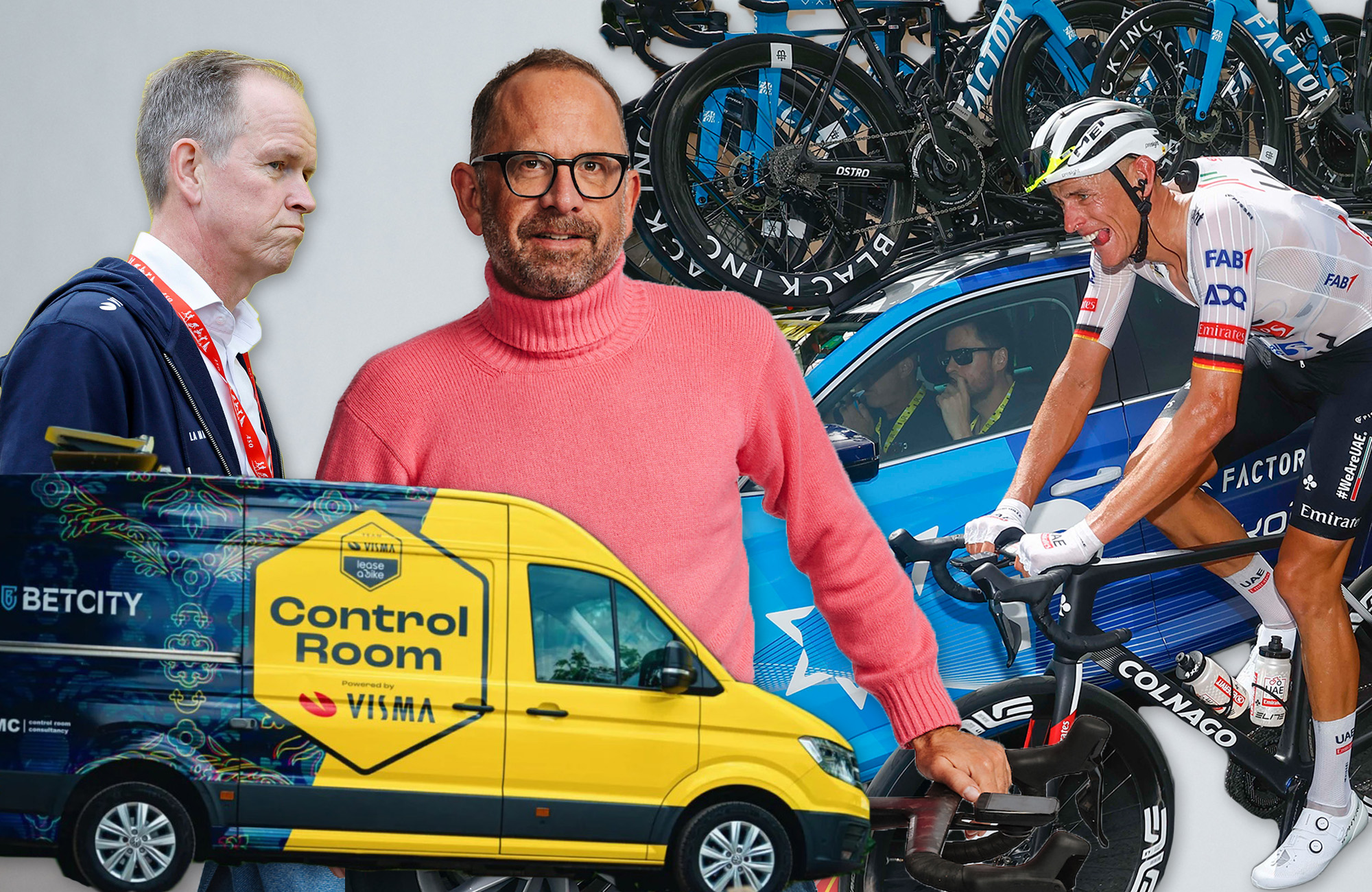Bologna, IT - On the morning of the Tour de France's stage 2, the day after Visma-Lease a Bike's control room van was barred from the race, EF Education-EasyPost posted the following tweet:
At the start line, the light barb was being well received amongst various teams in the start paddock. In a peloton of haves and comparative have-nots, Visma's van had likely both elicited eye-rolls and struck a slight fear into a peloton that's been playing catch-up with the Dutch squad for at least a couple of years.
While the van will not be present within the race bubble, the fact of the matter is this data-harvesting arms race has slowly been developing for years. Teams are and have been, barring any new breakthroughs contained within the van, doing exactly the same thing but using sofas instead of satellite-decorated vehicles.
In some ways, the lukewarm control room drama has been a bit of a storm in a teacup; the best team in the peloton do something that appears innovative, it gets banned from the race, and that's newsworthy. But whether, as pro rider coach Jacob Tipper told us earlier this week, there are unknown benefits (unknown to either Visma itself or everyone else in cycling) or a mere psychological advantage of seeming to have something others don't, only time will tell.
"We don't call it a command centre, we call it a couch. A command couch," EF Education-EasyPost boss Jonathan Vaughters told Escape Collective before the start of stage 1.
"It's not necessarily a new idea. For years we've been talking about the fact that quite simply a director in the car trying to look at a television feed that's sometimes there, sometimes not, sometimes the signal works, trying to do with GSM [cellular] networks that sometimes work, that's very inefficient.
"Sometimes, if I'm sitting in my house in Colorado watching the race," Vaughters continued, "I have better information than the directors do on the road. So fundamentally, that's a good idea. But what I would say is you don't need a van for that type of thing. Bluntly speaking, the way we do it is one of our directors is just at home with nice wifi and we have an open channel with the phone in the car at all times. So if that director at home is seeing something the directors can't they just speak up walkie-talkie style. We're just doing the budget version, we didn't go buy a van but we're doing pretty much the same thing."
Israel-Premier Tech sports director Sam Bewley agrees, explaining that seeking to uncouple broader information gathering from the team car's in-race responsibilities is a task that has been developing solutions over time.
"What Visma's doing with their control room is obviously an elaborate way of doing it, but at the same time it's where the sport's heading," Bewley told us before the start of stage 2.
"It's quite important, our team is probably a little bit further down the line than some other teams; we don't have vans following us around but we do have a couple of coaches at home who are feeding information by watching the race, keeping up with live updates and all of that sort of stuff. It's quite common amongst all of the teams that you have somebody who's not in the race car who can give you information because obviously you don't have TV coverage or mobile reception [all of the time] so you need someone who's able to do that."

And this is more important for broader tactics rather than, for instance, ensuring the safety of their riders to potential hazards ahead?
"If there's a mechanical or something we'll know about that [in the car first] because of Radio Tour," Bewley continued, "it's more about understanding exactly what the situation is, and some days it's a lot easier than other days, like if it's a straightforward sprint day and you have TV coverage, [cell] reception, and you can see the race, it's a little bit easier to manage but if you get a race like Paris-Roubaix or stage 9 of this year's Tour de France, [cars] will be a long way behind, there'll be groups all over the place because of the gravel, and you've got no idea really what's happening.
"So it's really important to have someone with a few screens in front of them so they can feed information to you so you're up to date quite quickly and you're not waiting for Radio Tour, and sometimes Radio Tour doesn't tell you exactly where your riders are so it's important on more hectic days to have that."
Some teams, such as Lidl-Trek, combine literal armchair DSes at home (rather than the term used to describe fans who think they know best and make their thoughts known online) with "scout teams" on the road, which can be the second in-race team car, with further support backing up this structure at home.
Asked to explain how their system worked just before the start of stage 2, Lidl-Trek gave us this outline of lead team car, secondary "scout" car and homebound support, but couldn't deliver us any specifics beyond that until after the stage, as all of their performance team (DSes and coaches) were either in-race or at home plugged into their communications network and focused on the ongoing Tour stage. Any outside communication is therefore kept to a minimum. Towards the end of the race, we did get confirmation that the scout car has radio communication with the lead car in order to feed any critical information picked up by staff at home.
"I think it's been evolving and developing more over the last few years," Bewley estimated. "Of course it's always been around but obviously the access to things like ProCyclingStats or different TV coverage has allowed teams to have more information and do this more effectively. It's always been around, probably started with someone calling somebody in the race car watching TV on the bus and now it's evolving to be more in-depth. I think in the last few years it's definitely progressed to become a bigger thing."
One humorous feature of Visma's van, as revealed by NBC, is they have trained software to be able to pick up the colour and movement of Tadej Pogačar on the television footage, so that they always know where he is on the road when the GC group is in view.
Following stage 2, Visma-Lease a Bike boss Richard Plugge offered conflicting accounts of how his team hadn't asked for the van to be part of the accredited vehicles on the race because it doesn't need to be, while also explaining he's asked for answers from Tour organisers for clarity on the rules the van wasn't following that led to it being barred.
"It's a nice innovation and I think this sport could use some innovation. Yeah, they did not give us a sticker, authorisation to be with the team, we never asked for it because we don't need it to be here. It's up to them to follow their rules but they had some considerations, why they did not want to give us the stickers, but I asked them if they could send me the rules which support these considerations and I'm very curious what the real reason is," Plugge said.
"At the end of the day I think it's very interesting, I got many messages from team leaders, one thanking me for leading the innovation and showing where the future of this sport will be. We want to drive innovation.
"It's not necessary to be in the race bubble," he insisted. "On the one hand it's an innovation on the other hand everyone is doing this, calling with people along the road, soigneurs, 'what is the situation?' because we all know sometimes we don't have connection. That's the reason why everyone is doing that and we're trying, especially for the safety of the sports directors in the race convoy, to give them space, and so they only have to respond to one source of information rather than different ones. It's an improvement, it's an innovation, but the way we do it now is a big improvement for safety in the race convoy and I don't think we can be against that."
In the race bubble or outside of it, in a van or on the couch, what is certain is cycling is in constant revolution, searching for small improvements that are sometimes invisible to those outside of the teams. Now, time to log back in to Twitter and fire off a tweet that has a very small, but still not impossible, chance of influencing today's stage.
Did we do a good job with this story?






